Project and Development of a Reinforcement Learning Based Control Algorithm for Hybrid Electric Vehicles
Abstract
:1. Introduction
- The distinction between state and observation space in case of application to (P)HEVs;
- The distinction between training and testing episodes;
- The definition of the most meaningful metrics and signals employed for analyzing the behavior of a Q-learning agent when applied to (P)HEVs;
- The identification of a test set of for the interpretation of the results obtained with the RL agent.
- The assessment of the effect produced by a modification of the discount factor on its capability of defining an admissible control policy for different DMs;
- The identification of the best fitting discount factor in case of a reward function focused on battery SoC sustaining as well as FC minimization;
- The assessment of the combined effect produced by changing the reward function along with the discount factor;
- The assessment of the effect produced by a change in the value of the learning rate;
- The demonstration of the RL agent response to a change in the exploration strategy.
2. Reinforcement Learning for Hybrid Electric Vehicles
- The entire trajectory of the vehicle velocity is not a priori known under real-time conditions;
- The DP mesh discretization level could be too fine for the on-board electronics to solve a control problem under real-world unpredictable driving scenarios, i.e., the DP cannot be implemented in the electronic control unit (ECU) under real-time conditions.
2.1. From Dynamic Programming to Reinforcement Learning
2.2. Discounted Return and Discount Factor
2.3. Exploration–Exploitation
2.4. Reward Function and Shaping
2.5. Q-Learning Algorithm
3. An Integrated Modular Software Framework for Hybrid Electric Vehicles
3.1. Simulator
3.2. Environment Component
3.3. Agent Component
3.4. Communication Interface
4. Results
- Effect of γ;
- Reward shaping;
- Sensitivity to α;
- Variation of the exploration strategy.
4.1. Effect of γ
4.2. Reward Shaping
4.3. Sensitivity to α
4.4. Variation of the Exploration Strategy
5. Discussion
6. Conclusions
Author Contributions
Funding
Institutional Review Board Statement
Informed Consent Statement
Acknowledgments
Conflicts of Interest
References
- Onori, S.; Serrao, L.; Rizzoni, G. Hybrid Electric Vehicles; Springer: London, UK, 2016. [Google Scholar]
- Cardoso, D.S.; Fael, P.O.; Espírito-Santo, A. A review of micro and mild hybrid systems. Energy Rep. 2020, 6, 385–390. [Google Scholar] [CrossRef]
- Enang, W.; Bannister, C. Modelling and control of hybrid electric vehicles (A comprehensive review). Renew. Sustain. Energy Rev. 2017, 74, 1210–1239. [Google Scholar] [CrossRef] [Green Version]
- Rizzo, G.; Naghinajad, S.; Tiano, F.A.; Marino, M. A survey on through-the-road hybrid electric vehicles. Electronics 2020, 9, 1–22. [Google Scholar] [CrossRef]
- Singh, K.V.; Bansal, H.O.; Singh, D. A comprehensive review on hybrid electric vehicles: Architectures and components. J. Mod. Transp. 2019, 27, 77–107. [Google Scholar] [CrossRef] [Green Version]
- Torreglosa, J.P.; Garcia-Triviño, P.; Vera, D.; López-García, D.A. Analyzing the improvements of energy management systems for hybrid electric vehicles using a systematic literature review: How far are these controls from rule-based controls used in commercial vehicles? Appl. Sci. 2020, 10, 1–25. [Google Scholar] [CrossRef]
- Martinez, C.M.; Hu, X.; Cao, D.; Velenis, E.; Gao, B.; Wellers, M. Energy Management in Plug-in Hybrid Electric Vehicles: Recent Progress and a Connected Vehicles Perspective. IEEE Trans. Veh. Technol. 2017, 66, 4534–4549. [Google Scholar] [CrossRef] [Green Version]
- Biswas, A.; Emadi, A. Energy management systems for electrified powertrains: State-of-the-art review and future trends. IEEE Trans. Veh. Technol. 2019, 68, 6453–6467. [Google Scholar] [CrossRef]
- Hofman, T.; van Druten, R.M.; Steinbuch, M.; Serrarens, A.F.A. Rule-Based Equivalent Fuel Consumption Minimization Strategies for Hybrid Vehicles; IFAC Proceedings Volumes 2008; IFAC: New York, NY, USA, 2008; Volume 41, ISBN 9783902661005. [Google Scholar] [CrossRef] [Green Version]
- Finesso, R.; Spessa, E.; Venditti, M. Robust equivalent consumption-based controllers for a dual-mode diesel parallel HEV. Energy Convers. Manag. 2016, 127, 124–139. [Google Scholar] [CrossRef]
- Lin, C.C.; Peng, H.; Grizzle, J.W.; Kang, J.M. Power management strategy for a parallel hybrid electric truck. IEEE Trans Control Syst Technol. IEEE Trans. Control Syst. Technol. 2003, 11, 839–849. [Google Scholar] [CrossRef] [Green Version]
- Huang, Y.; Wang, H.; Khajepour, A.; He, H.; Ji, J. Model predictive control power management strategies for HEVs: A review. J. Power Sources 2017, 341, 91–106. [Google Scholar] [CrossRef]
- Harold, C.K.D.; Prakash, S.; Hofman, T. Powertrain Control for Hybrid-Electric Vehicles Using Supervised Machine Learning. Vehicles 2020, 2, 267–286. [Google Scholar] [CrossRef]
- Finesso, R.; Spessa, E.; Venditti, M. An unsupervised machine-learning technique for the definition of a rule-based control strategy in a complex HEV. SAE Int. J. Altern. Powertrains 2016, 5, 308–327. [Google Scholar] [CrossRef]
- Ganesh, A.H.; Xu, B. A review of reinforcement learning based energy management systems for electrified powertrains: Progress, challenge, and potential solution. Renew. Sustain. Energy Rev. 2022, 154, 111833. [Google Scholar] [CrossRef]
- Sutton, R.S.; Barto, A.G. Reinforcement Learning: An Introduction; MIT Press: Cambridge, MA, USA, 2018. [Google Scholar]
- Zhu, Z.; Liu, Y.; Canova, M. Energy Management of Hybrid Electric Vehicles via Deep Q-Networks. In Proceedings of the 2020 American Control Conference (ACC), Denver, CO, USA, 1–3 July 2020; pp. 3077–3082. [Google Scholar] [CrossRef]
- Han, X.; He, H.; Wu, J.; Peng, J.; Li, Y. Energy management based on reinforcement learning with double deep Q-learning for a hybrid electric tracked vehicle. Appl. Energy 2019, 254, 113708. [Google Scholar] [CrossRef]
- Li, Y.; He, H.; Khajepour, A.; Wang, H.; Peng, J. Energy management for a power-split hybrid electric bus via deep reinforcement learning with terrain information. Appl. Energy 2019, 255, 113762. [Google Scholar] [CrossRef]
- Liu, T.; Zou, Y.; Liu, D.; Sun, F. Reinforcement Learning of Adaptive Energy Management With Transition Probability for a Hybrid Electric Tracked Vehicle. IEEE Trans. Ind. Electron. 2015, 62, 7837–7846. [Google Scholar] [CrossRef]
- Liu, T.; Hu, X.; Li, S.E.; Cao, D. Reinforcement Learning Optimized Look-Ahead Energy Management of a Parallel Hybrid Electric Vehicle. IEEE/ASME Trans. Mechatron. 2017, 22, 1497–1507. [Google Scholar] [CrossRef]
- Mittal, N.; Pundlikrao Bhagat, A.; Bhide, S.; Acharya, B.; Xu, B.; Paredis, C. Optimization of Energy Management Strategy for Range-Extended Electric Vehicle Using Reinforcement Learning and Neural Network. SAE Tech. Pap. 2020, 2020, 1–12. [Google Scholar] [CrossRef]
- Biswas, A.; Anselma, P.G.; Emadi, A. Real-Time Optimal Energy Management of Electrified Powertrains with Reinforcement Learning. In Proceedings of the 2019 IEEE Transportation Electrification Conference and Expo (ITEC), Detroit, MI, USA, 19–21 June 2019. [Google Scholar] [CrossRef]
- Xu, B.; Rathod, D.; Zhang, D.; Yebi, A.; Zhang, X.; Li, X.; Filipi, Z. Parametric study on reinforcement learning optimized energy management strategy for a hybrid electric vehicle. Appl. Energy 2020, 259, 114200. [Google Scholar] [CrossRef]
- Ehsani, M.; Gao, Y.; Longo, S.; Ebrahimi, K.M. Modern Electric Hybrid Electric and Fuel Cell Vehicles; CRC Press: Boca Raton, FL, USA, 2018. [Google Scholar]
- Sundström, O.; Guzzella, L. A generic dynamic programming Matlab function. In Proceedings of the 2009 IEEE Control Applications, (CCA) & Intelligent Control, (ISIC), St. Petersburg, Russia, 8–10 July 2009. [Google Scholar] [CrossRef]
- Finesso, R.; Spessa, E.; Venditti, M. Cost-optimized design of a dual-mode diesel parallel hybrid electric vehicle for several driving missions and market scenarios. Appl. Energy 2016, 177, 366–383. [Google Scholar] [CrossRef]
- Finesso, R.; Misul, D.; Spessa, E.; Venditti, M. Optimal design of power-split HEVs based on total cost of ownership and CO2 emission minimization. Energies 2018, 11, 1705. [Google Scholar] [CrossRef] [Green Version]
- Maino, C.; Misul, D.; Musa, A.; Spessa, E. Optimal mesh discretization of the dynamic programming for hybrid electric vehicles. Appl. Energy 2021, 292, 116920. [Google Scholar] [CrossRef]
- Spaan, M.T.J. Partially Observable Markon Decision Processes. In Reinforcement Learning. Adaptation, Learning, and Optimization; Springer: Berlin/Heidelberg, Germany, 2012. [Google Scholar]
- Watkins, C.J.C.H. Learning from Delayed Rewards. PhD Thesis, King’s College, London, UK, 1989. [Google Scholar]
- Brockman, G.; Cheung, V.; Pettersson, L.; Schneider, J.; Schulman, J.; Tang, J.; Zaremba, W. OpenAI Gym. arXiv 2016, arXiv:1606.01540. [Google Scholar]
- Van Rossum, G. The Python Lybrary Reference, Release 3.8.5; Python Software Foundation: Wilmington, DE, USA, 2020. [Google Scholar]
- Finesso, R.; Spessa, E.; Venditti, M. Optimization of the layout and control strategy for parallel through-the-road hybrid electric vehicles. SAE Tech. Pap. 2014, 1. [Google Scholar] [CrossRef]
- Anselma, P.G.; Belingardi, G.; Falai, A.; Maino, C.; Miretti, F.; Misul, D.; Spessa, E. Comparing parallel hybrid electric vehicle powertrains for real-world driving. In Proceedings of the 2019 AEIT International Conference of Electrical and Electronic Technologies for Automotive (AEIT AUTOMOTIVE), Turin, Italy, 2–4 July 2019. [Google Scholar] [CrossRef]
- Maino, C.; Misul, D.; Di Mauro, A.; Spessa, E. A deep neural network based model for the prediction of hybrid electric vehicles carbon dioxide emissions. Energy AI 2021, 5, 100073. [Google Scholar] [CrossRef]
- Fusco, G.; Bracci, A.; Caligiuri, T.; Colombaroni, C.; Isaenko, N. Experimental analyses and clustering of travel choice behaviours by floating car big data in a large urban area. IET Intell. Transp. Syst. 2018, 12, 270–278. [Google Scholar] [CrossRef]
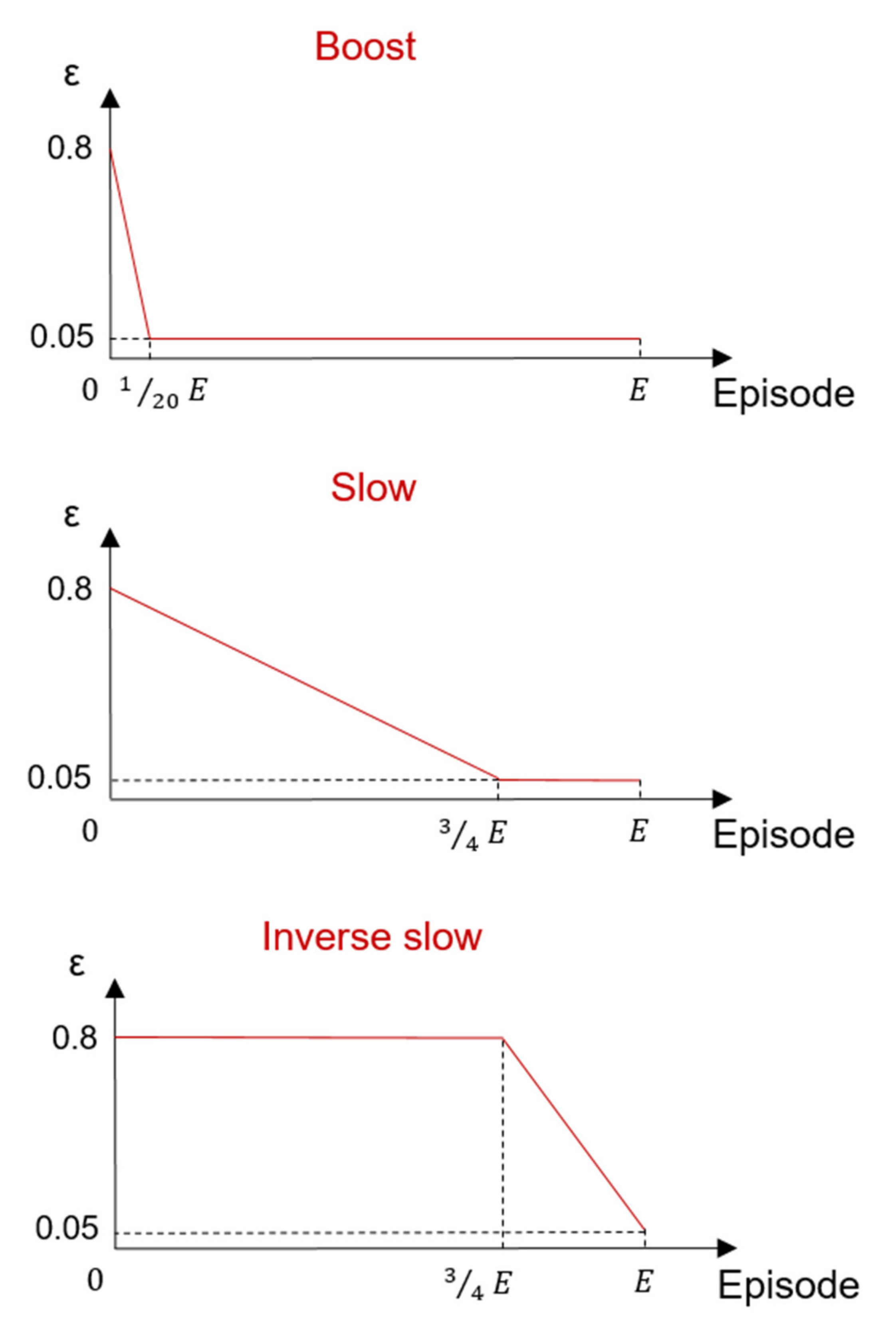
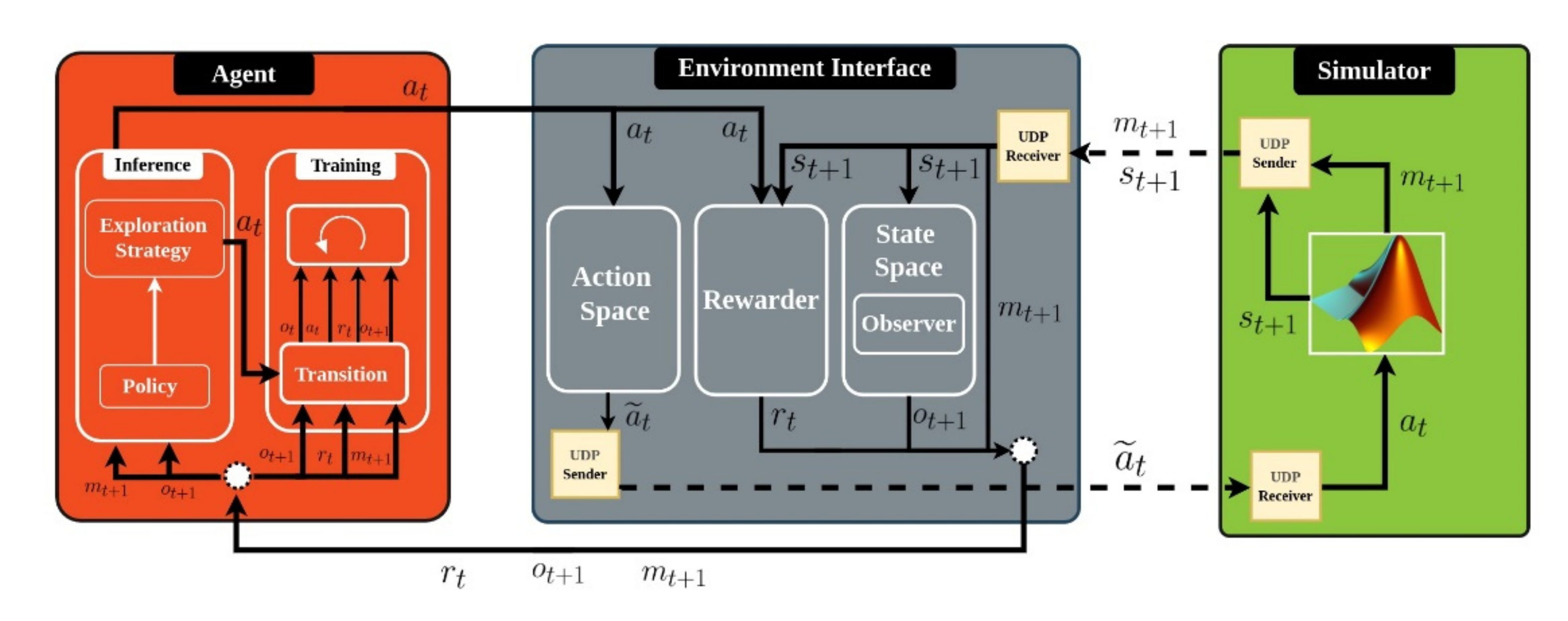
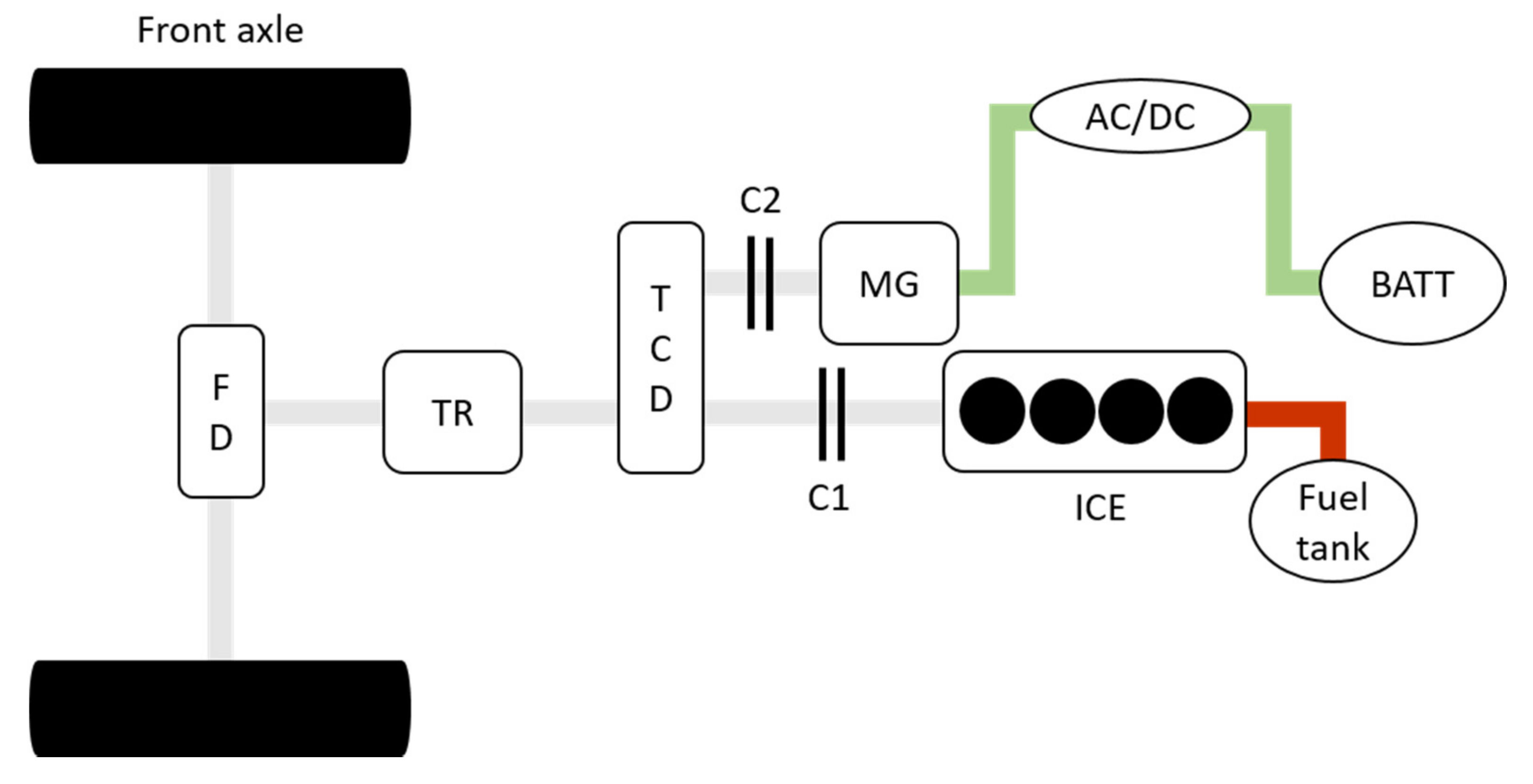
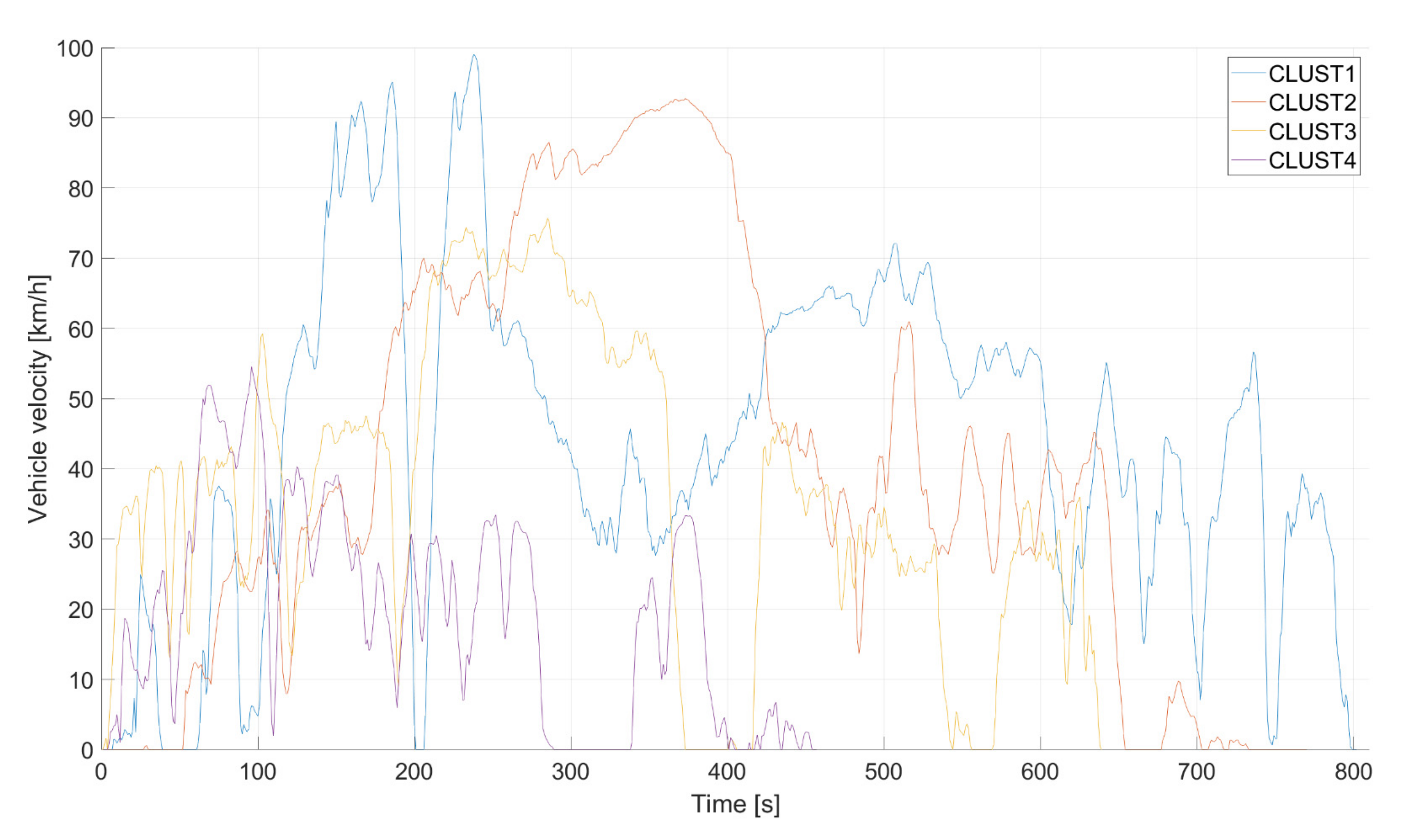

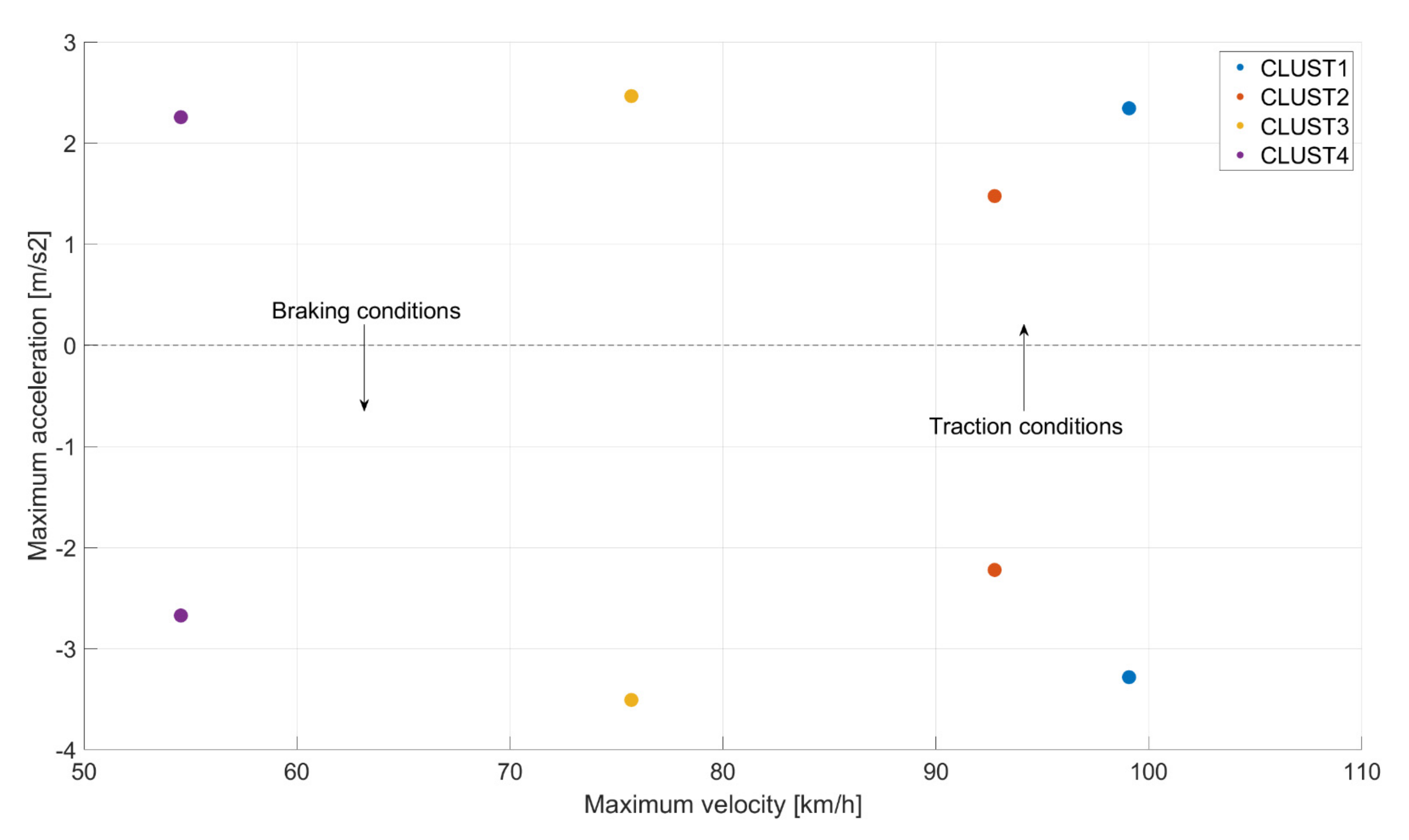
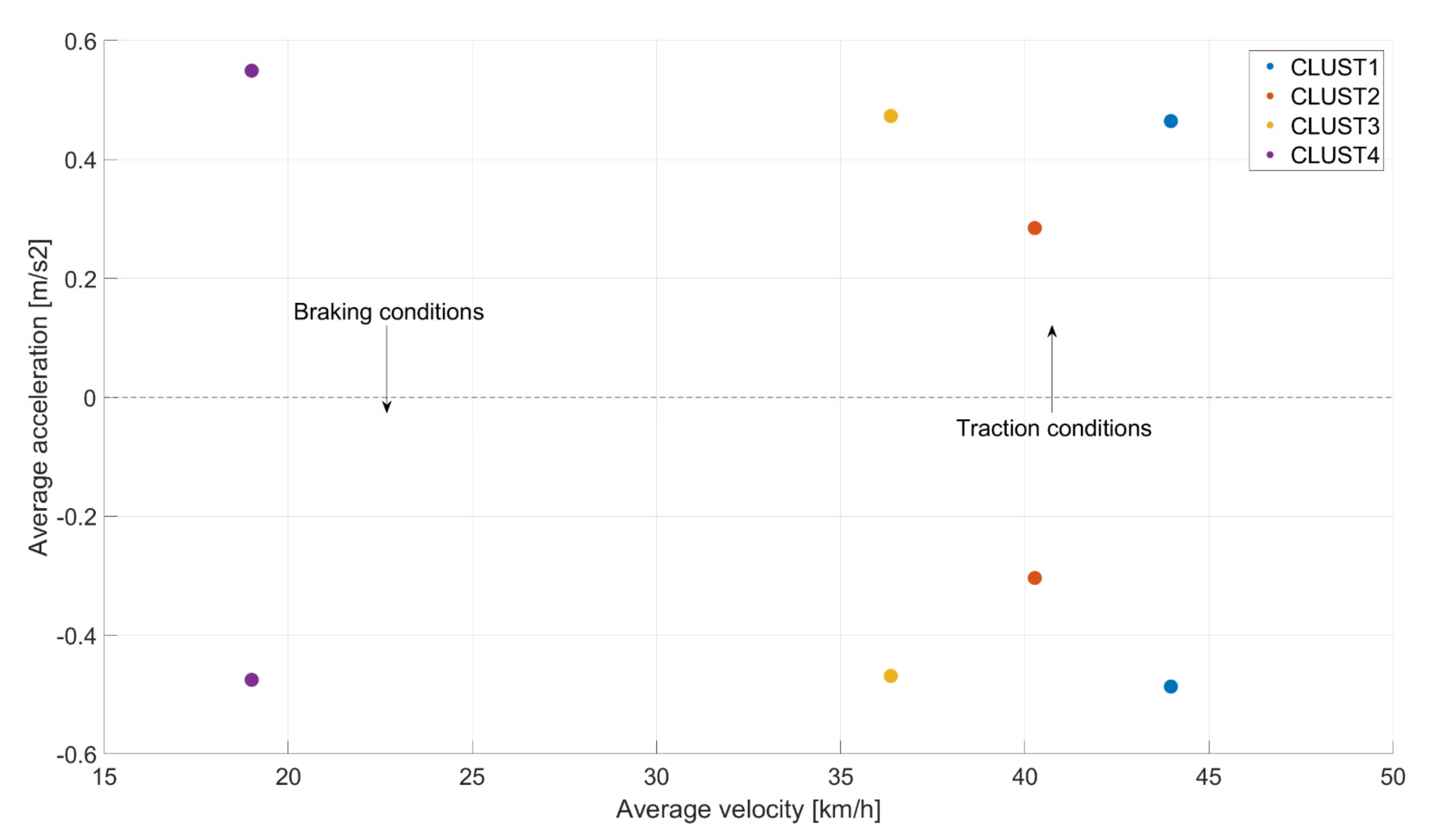

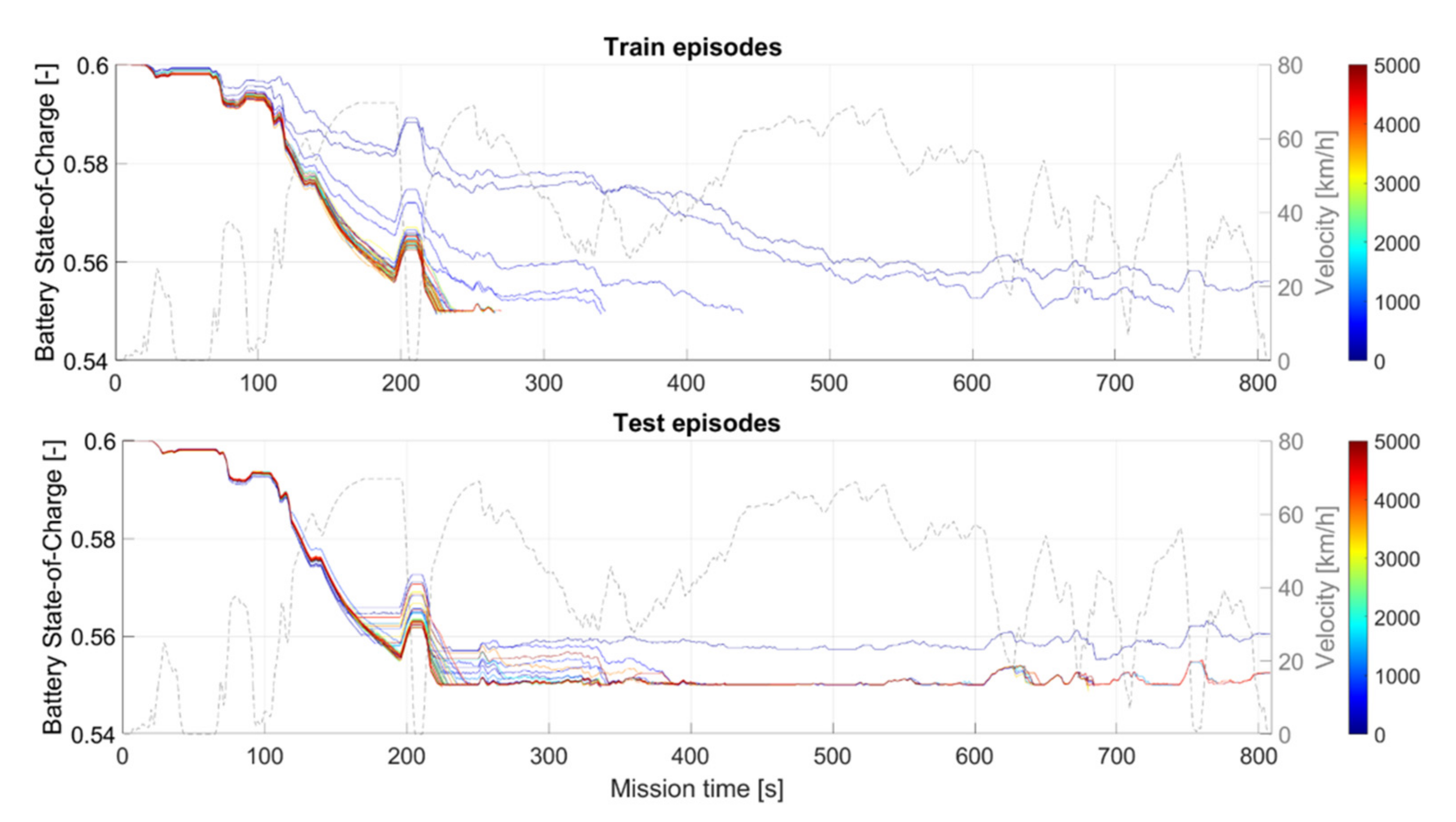

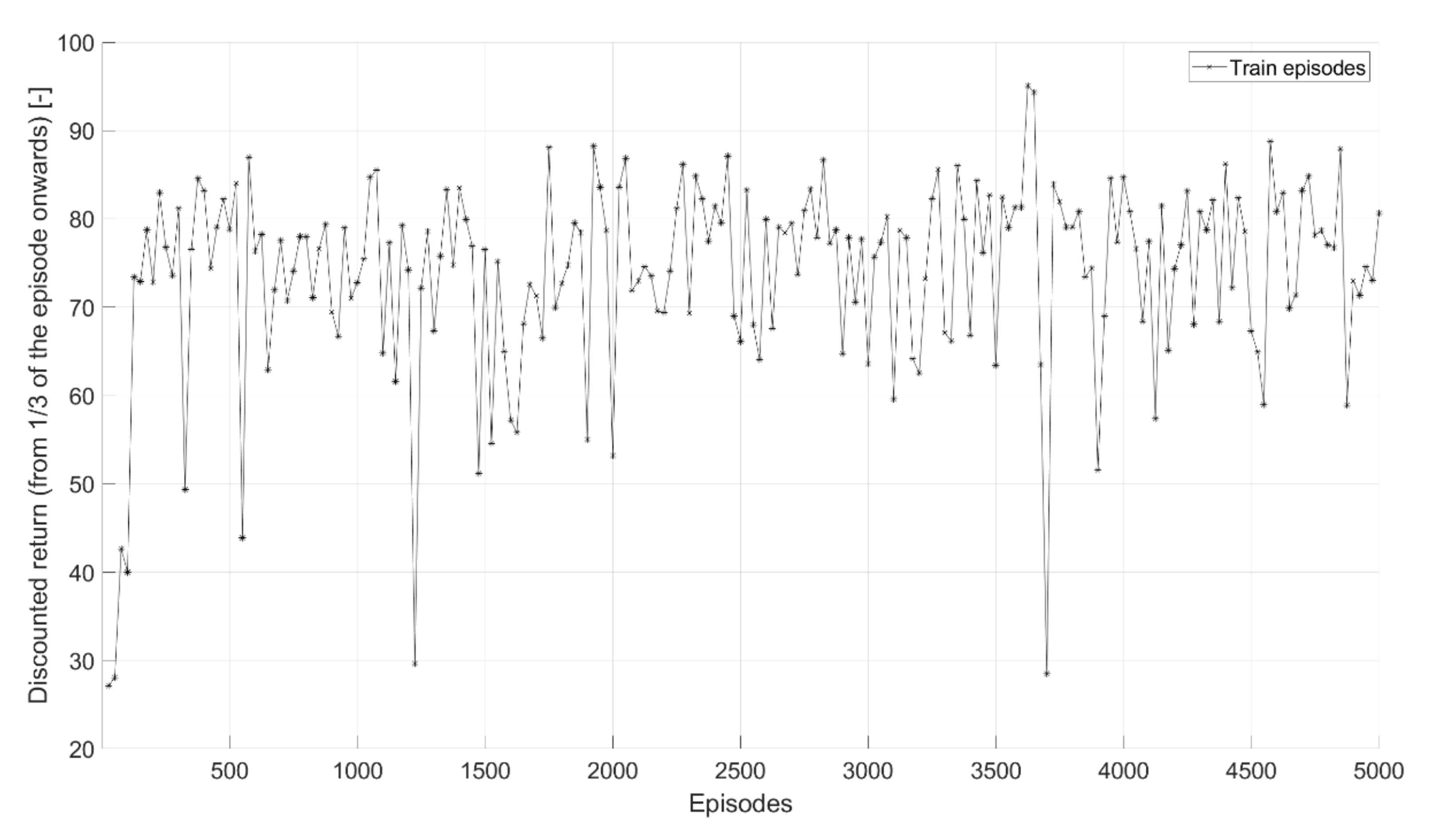


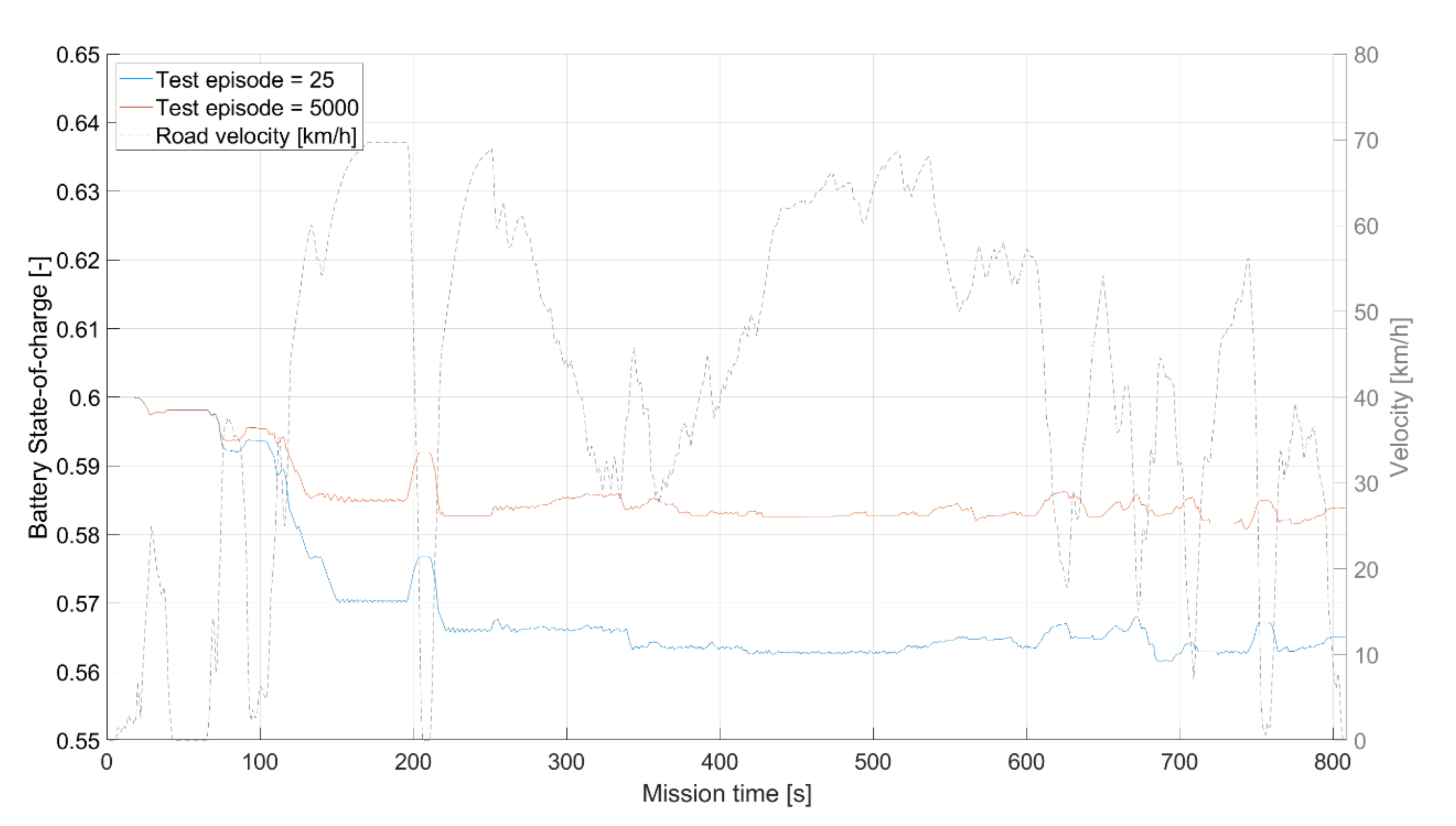
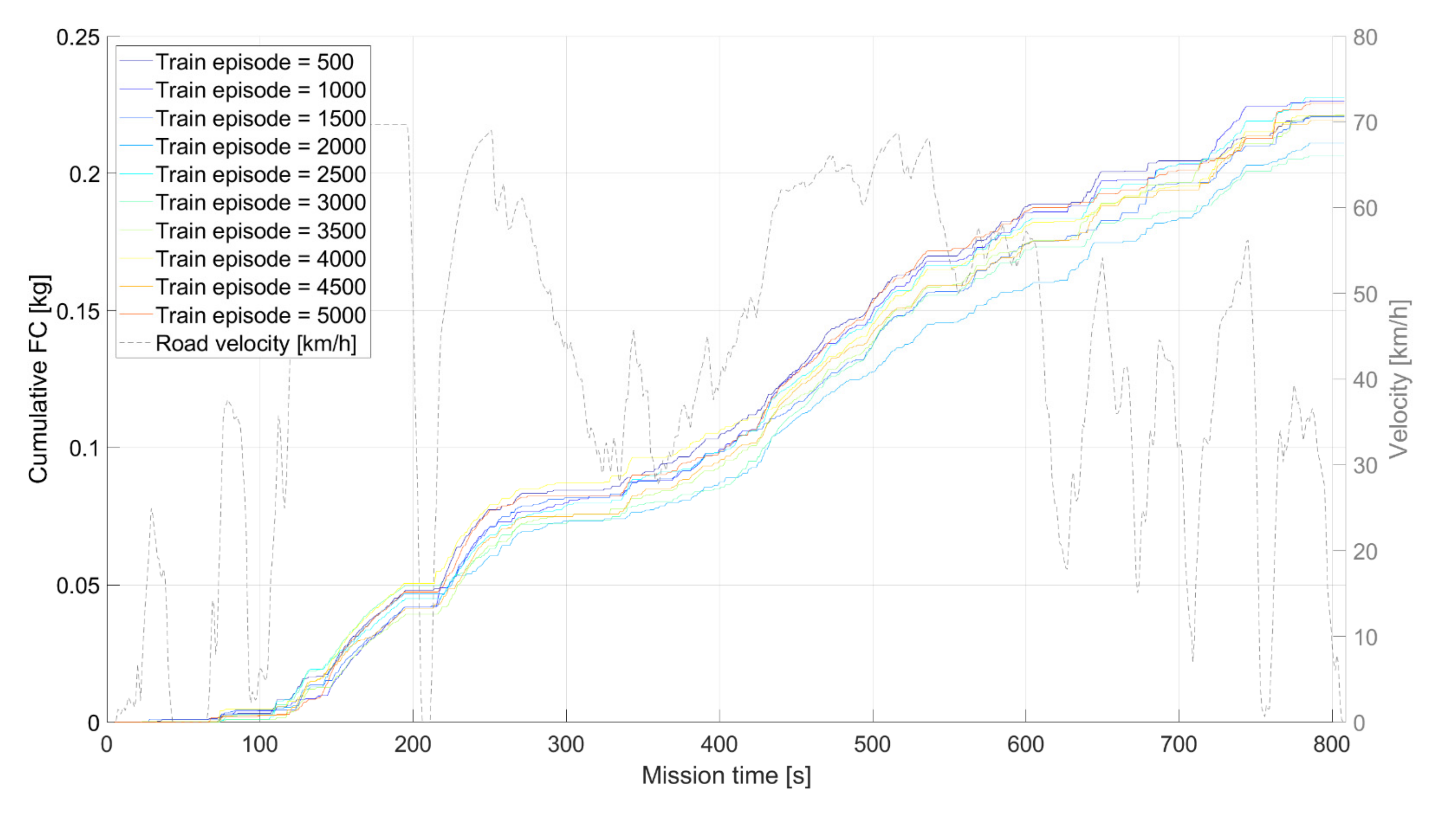


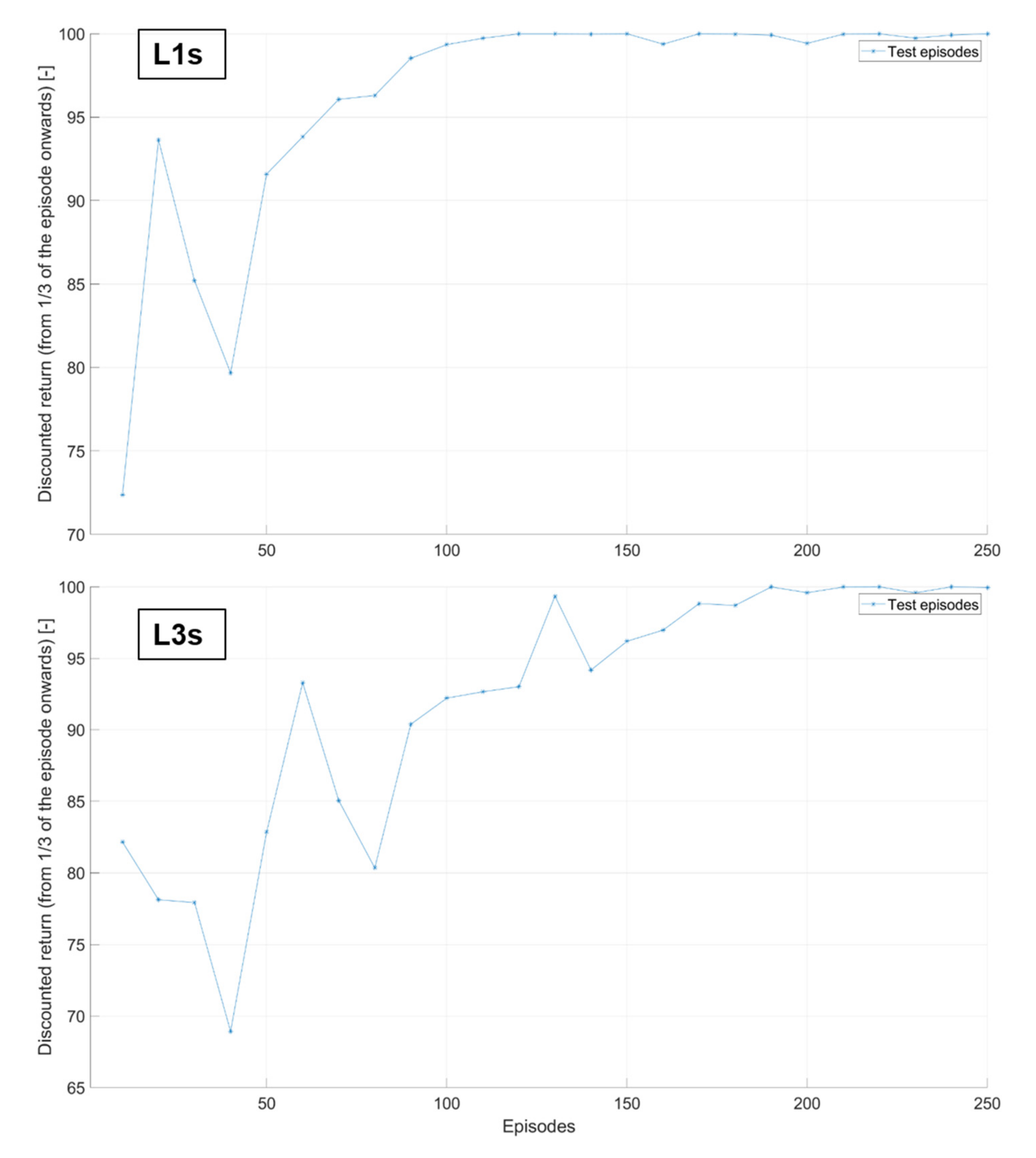
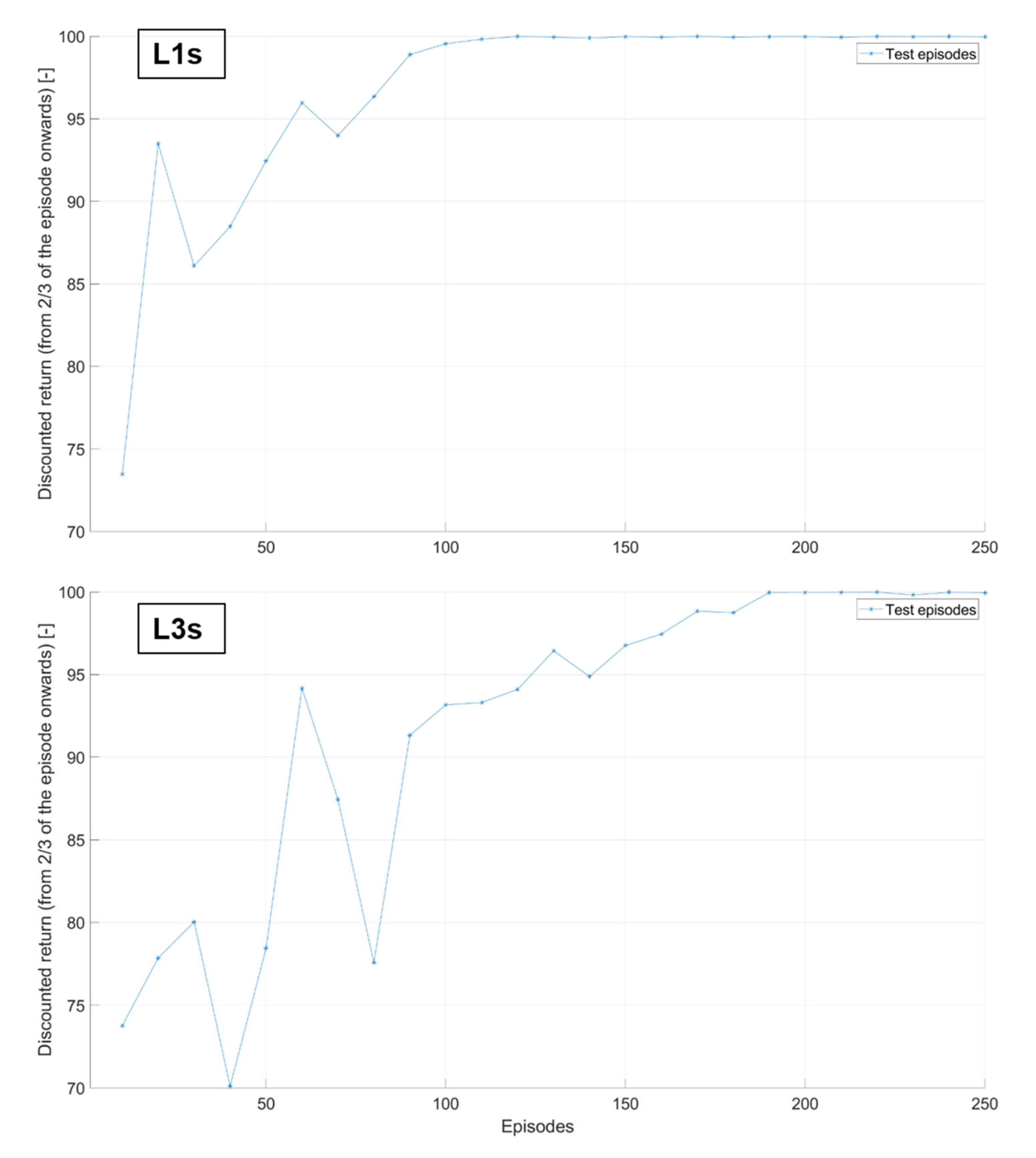
| General Specifications | |
|---|---|
| Vehicle class | Passenger car |
| Kerb weight (kg) | 750 |
| Vehicle mass (w/pwt components) | 1200 |
| Transmission | 6-gears |
| Internal Combustion Engine | |
| Fuel type | Gasoline |
| Maximum power (kW (@ rpm)) | 88 (@ 5500) |
| Maximum torque (Nm (@ rpm)) | 180 (@ 1750–4000) |
| Rotational speed range (rpm) | 0–6250 |
| Motor-generator | |
| Maximum power (kW (@ rpm)) | 70 (@ 6000) |
| Maximum torque (Nm (@ rpm)) | 154 (@ 0–4000) |
| Rotational speed range (rpm) | 0–13500 |
| Battery | |
| Peak power (kW) | 74 |
| Energy content (kWh) | 6.1 |
| AC/DC converter efficiency (-) | 0.95 |
| DM | FC (g) | |||||||
|---|---|---|---|---|---|---|---|---|
| DP | Ql γ = 0.9 | Ql γ = 0.99 | Ql γ = 0.999 | DP | Ql γ = 0.9 | Ql γ = 0.99 | Ql γ = 0.999 | |
| CLUST1 | 0.6000 | 0.5838 | 0.5939 | 0.5904 | 246.6 | 229.91 | 263.20 | 244.47 |
| CLUST2 | 0.6000 | 0.5826 | 0.5962 | 0.6000 | 197.2 | 227.19 | 255.38 | 263.46 |
| CLUST3 | 0.6000 | 0.5817 | 0.5754 | - | 152.6 | 173.02 | 169.26 | - |
| CLUST4 | 0.6000 | 0.5819 | 0.6019 | 0.5974 | 53.9 | 52.07 | 106.56 | 93.81 |
| rFC (g) | (%) | |||||||
| CLUST1 | 246.6 | 253.21 | 272.02 | 258.27 | - | 2.68 | 10.31 | 4.73 |
| CLUST2 | 197.2 | 252.28 | 260.9 | 263.46 | - | 27.93 | 32.30 | 33.60 |
| CLUST3 | 152.6 | 199.33 | 204.7 | - | - | 30.62 | 34.14 | - |
| CLUST4 | 53.9 | 78.21 | 106.56 | 97.59 | - | 45.10 | 97.70 | 81.06 |
| γ | DM | FC (g) | |||||||||||
|---|---|---|---|---|---|---|---|---|---|---|---|---|---|
| DP | R1 | R2a | R2b | R2c | R3 | DP | R1 | R2a | R2b | R2c | R3 | ||
| 0.9 | CLUST1 | 0.6000 | 0.5838 | - | - | - | 0.5977 | 246.6 | 229.91 | - | - | - | 259.89 |
| CLUST2 | 0.6000 | 0.5826 | - | - | - | 0.6000 | 197.2 | 227.19 | - | - | - | 282.63 | |
| CLUST3 | 0.6000 | 0.5817 | - | - | - | - | 152.6 | 173.02 | - | - | - | - | |
| CLUST4 | 0.6000 | 0.5819 | - | - | - | 0.5884 | 53.9 | 52.07 | - | - | - | 66.52 | |
| rFC (g) | (%) | ||||||||||||
| CLUST1 | 246.6 | 253.21 | - | - | - | 263.13 | - | 2.68 | - | - | - | 6.70 | |
| CLUST2 | 197.2 | 252.28 | - | - | - | 282.63 | - | 27.93 | - | - | - | 43.32 | |
| CLUST3 | 152.6 | 199.33 | - | - | - | - | - | 30.62 | - | - | - | - | |
| CLUST4 | 53.9 | 78.21 | - | - | - | 83.29 | - | 45.10 | - | - | - | 54.53 | |
| γ | DM | FC (g) | |||||||||||
|---|---|---|---|---|---|---|---|---|---|---|---|---|---|
| DP | R1 | R2a | R2b | R2c | R3 | DP | R1 | R2a | R2b | R2c | R3 | ||
| 0.99 | CLUST1 | 0.6000 | 0.5939 | - | - | - | 0.6018 | 246.6 | 263.20 | - | - | - | 280.80 |
| CLUST2 | 0.6000 | 0.5962 | - | - | - | 0.6031 | 197.2 | 255.38 | - | - | - | 254.28 | |
| CLUST3 | 0.6000 | 0.5754 | - | - | - | - | 152.6 | 169.26 | - | - | - | - | |
| CLUST4 | 0.6000 | 0.6019 | - | - | - | 0.5984 | 53.9 | 106.56 | - | - | - | 88.48 | |
| rFC (g) | (%) | ||||||||||||
| CLUST1 | 246.6 | 272.02 | - | - | - | 280.83 | - | 10.31 | - | - | - | 13.88 | |
| CLUST2 | 197.2 | 260.9 | - | - | - | 254.28 | - | 32.30 | - | - | - | 28.95 | |
| CLUST3 | 152.6 | 204.7 | - | - | - | - | - | 34.14 | - | - | - | - | |
| CLUST4 | 53.9 | 106.56 | - | - | - | 90.86 | - | 97.70 | - | - | - | 68.57 | |
| γ | DM | FC (g) | |||||||||||
|---|---|---|---|---|---|---|---|---|---|---|---|---|---|
| DP | R1 | R2a | R2b | R2c | R3 | DP | R1 | R2a | R2b | R2c | R3 | ||
| 0.999 | CLUST1 | 0.6000 | 0.5904 | - | - | - | 0.6011 | 246.6 | 244.47 | - | - | - | 293.15 |
| CLUST2 | 0.6000 | 0.6000 | - | - | - | 0.6049 | 197.2 | 263.46 | - | - | - | 266.82 | |
| CLUST3 | 0.6000 | - | - | - | - | 0.5795 | 152.6 | - | - | - | - | 185.51 | |
| CLUST4 | 0.6000 | 0.5974 | - | - | - | 0.5982 | 53.9 | 93.81 | - | - | - | 95.23 | |
| rFC (g) | (%) | ||||||||||||
| CLUST1 | 246.6 | 258.27 | - | - | - | 293.15 | - | 4.73 | - | - | - | 18.88 | |
| CLUST2 | 197.2 | 263.46 | - | - | - | 266.82 | - | 33.60 | - | - | - | 35.30 | |
| CLUST3 | 152.6 | - | - | - | - | 214.99 | - | - | - | - | - | 40.88 | |
| CLUST4 | 53.9 | 97.59 | - | - | - | 97.86 | - | 81.06 | - | - | - | 81.56 | |
| DM | FC (g) | |||||||
|---|---|---|---|---|---|---|---|---|
| DP | Ql α = 0.1 | Ql α = 0.5 | Ql α = 0.9 | DP | Ql α = 0.1 | Ql α = 0.5 | Ql α = 0.9 | |
| CLUST1 | 0.6000 | 0.5778 | 0.6014 | 0.5838 | 246.6 | 226.51 | 298.62 | 229.91 |
| CLUST2 | 0.6000 | 0.5832 | 0.6021 | 0.5826 | 197.2 | 207.42 | 280.22 | 227.19 |
| CLUST3 | 0.6000 | - | - | 0.5817 | 152.6 | - | - | 173.02 |
| CLUST4 | 0.6000 | - | 0.6003 | 0.5819 | 53.9 | - | 101.89 | 52.07 |
| rFC (g) | (%) | |||||||
| CLUST1 | 246.6 | 258.65 | 298.62 | 253.21 | - | 4.89 | 21.09 | 2.68 |
| CLUST2 | 197.2 | 231.65 | 280.22 | 252.28 | - | 17.47 | 42.10 | 27.93 |
| CLUST3 | 152.6 | - | - | 199.33 | - | - | - | 30.62 |
| CLUST4 | 53.9 | - | 101.89 | 78.21 | - | - | 89.04 | 45.10 |
| DM | FC (g) | |||||||
|---|---|---|---|---|---|---|---|---|
| DP | L1 | L2 | L3 | DP | L1 | L2 | L3 | |
| CLUST1 | 0.6000 | 0.5838 | 0.6020 | 0.6017 | 246.6 | 229.91 | 309.01 | 269.35 |
| CLUST2 | 0.6000 | 0.5826 | 0.6020 | 0.6022 | 197.2 | 227.19 | 299.63 | 255.55 |
| CLUST3 | 0.6000 | 0.5817 | - | - | 152.6 | 173.02 | - | - |
| CLUST4 | 0.6000 | 0.5819 | 0.6010 | 0.6010 | 53.9 | 52.07 | 88.09 | 90.33 |
| rFC (g) | (%) | |||||||
| CLUST1 | 246.6 | 253.21 | 309.01 | 269.35 | - | 2.68 | 25.31 | 9.23 |
| CLUST2 | 197.2 | 252.28 | 299.63 | 255.55 | - | 27.93 | 51.94 | 29.59 |
| CLUST3 | 152.6 | 199.33 | - | - | - | 30.62 | - | - |
| CLUST4 | 53.9 | 78.21 | 88.09 | 90.33 | - | 45.10 | 63.43 | 67.59 |
| DM | FC (g) | rFC (g) | ||||
|---|---|---|---|---|---|---|
| L1s | L3s | L1s | L3s | L1s | L3s | |
| CLUST1 | 0.6014 | 0.6010 | 267.74 | 286.08 | 267.74 | 286.08 |
Publisher’s Note: MDPI stays neutral with regard to jurisdictional claims in published maps and institutional affiliations. |
© 2022 by the authors. Licensee MDPI, Basel, Switzerland. This article is an open access article distributed under the terms and conditions of the Creative Commons Attribution (CC BY) license (https://creativecommons.org/licenses/by/4.0/).
Share and Cite
Maino, C.; Mastropietro, A.; Sorrentino, L.; Busto, E.; Misul, D.; Spessa, E. Project and Development of a Reinforcement Learning Based Control Algorithm for Hybrid Electric Vehicles. Appl. Sci. 2022, 12, 812. https://doi.org/10.3390/app12020812
Maino C, Mastropietro A, Sorrentino L, Busto E, Misul D, Spessa E. Project and Development of a Reinforcement Learning Based Control Algorithm for Hybrid Electric Vehicles. Applied Sciences. 2022; 12(2):812. https://doi.org/10.3390/app12020812
Chicago/Turabian StyleMaino, Claudio, Antonio Mastropietro, Luca Sorrentino, Enrico Busto, Daniela Misul, and Ezio Spessa. 2022. "Project and Development of a Reinforcement Learning Based Control Algorithm for Hybrid Electric Vehicles" Applied Sciences 12, no. 2: 812. https://doi.org/10.3390/app12020812
APA StyleMaino, C., Mastropietro, A., Sorrentino, L., Busto, E., Misul, D., & Spessa, E. (2022). Project and Development of a Reinforcement Learning Based Control Algorithm for Hybrid Electric Vehicles. Applied Sciences, 12(2), 812. https://doi.org/10.3390/app12020812








